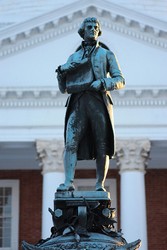Thomas Jefferson University Of Virginia
|
| updated |
Copy Link Code
|
 Founded in 1819 by Thomas Jefferson, University of Virginia was designed to be an ideal provider of liberal education to the best and brightest students in the early United States of America. Jefferson first made clear his plans to establish a public university in 1800 while writing a letter to a friend in England. Over the next two decades, Jefferson and his elite, well-educated circle of acquaintances discussed and debated the structure of such an academy. For students of the University of Virginia, Thomas Jefferson was adamant that greater variety of curriculum would be available as compared to the three majors available at every other contemporary university: medicine, theology and law. The first students, who began classes in March 1825, were able to choose from Astronomy, Architecture, Botany, Philosophy, and Political Science. Also unique for the time, under the direction of Thomas Jefferson, university library buildings were positioned centrally on the campus grounds instead of a church. Without any designs to teach Theology, Jefferson's new college broke from the norm and established new parameters for the mission of higher education.
Founded in 1819 by Thomas Jefferson, University of Virginia was designed to be an ideal provider of liberal education to the best and brightest students in the early United States of America. Jefferson first made clear his plans to establish a public university in 1800 while writing a letter to a friend in England. Over the next two decades, Jefferson and his elite, well-educated circle of acquaintances discussed and debated the structure of such an academy. For students of the University of Virginia, Thomas Jefferson was adamant that greater variety of curriculum would be available as compared to the three majors available at every other contemporary university: medicine, theology and law. The first students, who began classes in March 1825, were able to choose from Astronomy, Architecture, Botany, Philosophy, and Political Science. Also unique for the time, under the direction of Thomas Jefferson, university library buildings were positioned centrally on the campus grounds instead of a church. Without any designs to teach Theology, Jefferson's new college broke from the norm and established new parameters for the mission of higher education.
Although Thomas Jefferson was involved in numerous crucial events in the formation and governing of the nascent United States, he prized the University of Virginia as one of his greatest contributions to the nation. He asked that his tombstone mention only his role in drafting the Declaration of Independence, the Virginia Statute for Religious Freedom and the founding of the University of Virginia. That he would not even ask for recognition of his presidency over his establishment of the University should demonstrate his own estimation of its importance. Jefferson is still the only President of the United States to have founded an academic institution. With his radical new theories of non-religious education, Jefferson certainly changed the role and capability of academics in society. Instead of producing only priests, doctors, and lawyers, the University of Virginia was capable of providing society with inventive leaders and bold scientists in a time when reason came to trump superstition.
The University of Virginia was built on land that had previously been owned by another president, James Monroe. Monroe sold the land to Virginia's Board of Visitors as Central College in 1817 and in the same year the first cornerstone for Jefferson's future university was laid. In January 1819, the Commonwealth of Virginia created a charter for the University of Virginia under the direction of Thomas Jefferson. Jefferson managed every detail of the plans for the new college, including the layout for its "Academical Village". This central area of the University of Virginia included manicured gardens surrounded by residential and academic buildings. At the very center of the campus was the majestic Rotunda, based on the Pantheon of Rome. Numerous universities in the Eastern United States were designed with inspiration from Jefferson's Academical Village, Rotunda and Lawn. Jefferson financed the original construction of the campus buildings using personal loans from James Monroe and a plantation owner named Gen. John Hartwell Cocke. Jefferson never repaid these loans.
